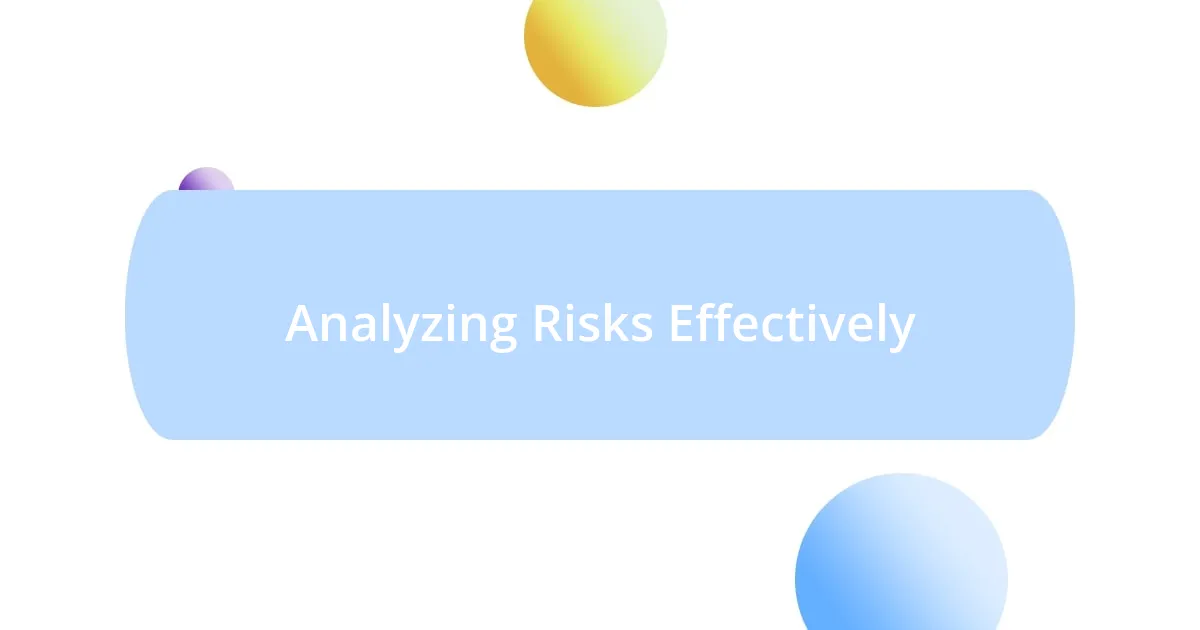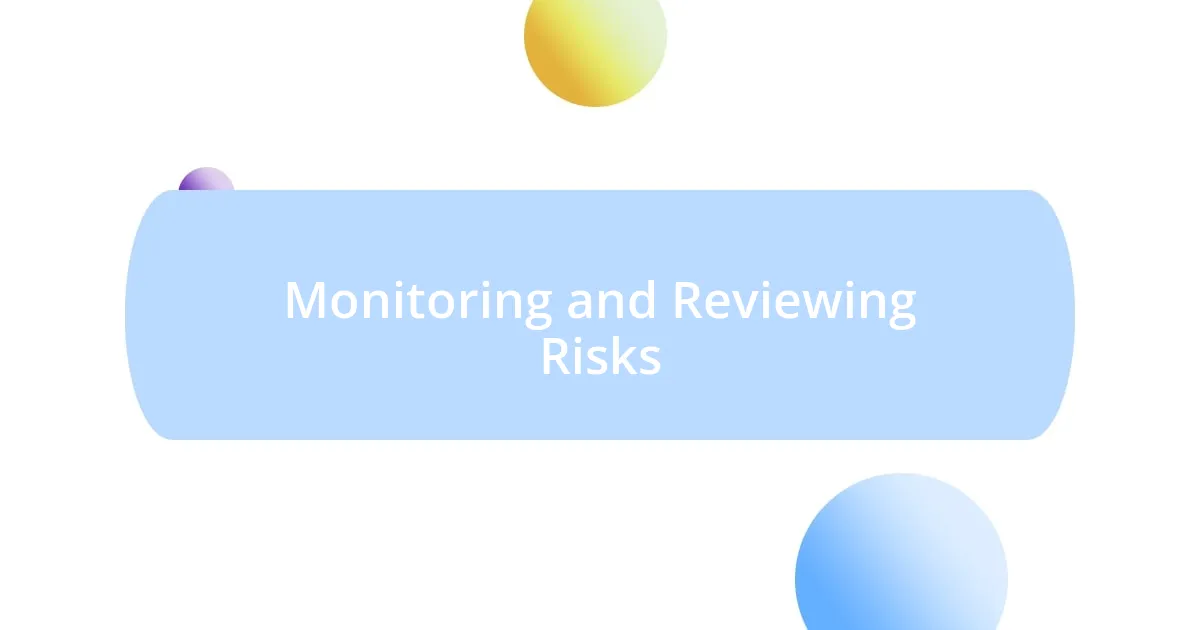Key takeaways:
- Risk management involves identifying, assessing, and prioritizing risks to empower decision-making across projects.
- Engaging the team and stakeholders in risk analysis leads to a more comprehensive understanding and fosters collaboration.
- Developing and implementing robust mitigation strategies can transform potential risks into manageable challenges and opportunities for growth.
- Regular monitoring and reviewing of risks, along with reflection on past experiences, are essential for continuous improvement and effective risk management.

Understanding Risk Management Basics
Risk management is like a safety net woven intricately through various aspects of life and business. I remember a time when my team faced a looming project deadline with uncertainties; we made a conscious effort to identify potential risks—not just the technical ones, but also team morale and resource availability. It struck me that understanding risk is not just about avoiding pitfalls; it’s about creating a buffer against surprises that can unsettle our best-laid plans.
At its core, risk management revolves around identifying, assessing, and prioritizing risks, a systematic approach that, if done right, can empower decision-making. Have you ever considered how often we navigate risks without realizing it? For instance, I’ve had moments on personal projects where I underestimated the time required, reminding me that the anticipation of setbacks is vital, not just for projects but for our peace of mind as well.
Furthermore, the emotional aspect of risk management cannot be overlooked. I vividly recall consulting with a friend who feared making a significant investment. Introducing him to a risk assessment framework helped him see beyond his apprehension. The relief on his face when he realized he could outline risks and develop strategies not only reassured him but also strengthened my belief in the transformative power of understanding risk management fundamentals.

Identifying Risks in Your Context
Identifying risks in your specific context requires a deep dive into the nuances of your environment. I recall a project where my team was tasked with launching a new product. As we brainstormed, we realized that market trends and customer sentiments could pose significant risks—things I hadn’t initially considered. This experience taught me the importance of looking at risks from multiple angles, rather than just the obvious technical ones.
To effectively identify risks, consider the following:
- Environmental Factors: What external conditions could impact your project? Think about regulatory changes or economic shifts.
- Stakeholder Perspectives: How do the hopes and concerns of team members and customers shape risk? I’ve found that varied opinions provide a broader risk landscape.
- Historical Data: Reflect on past projects. What challenges arose unexpectedly, and how can those inform your current approach?
- Resource Availability: Are there constraints related to resources that could hinder progress? I’ve often faced surprises in this area, leading to strategic pivots.
- Scenario Analysis: Engage in ‘what-if’ exercises to foresee potential barriers. I once hosted a brainstorming session solely to explore worst-case scenarios, which opened up critical discussions I hadn’t anticipated.

Analyzing Risks Effectively
Analyzing risks effectively starts with gathering data that can provide insights into potential pitfalls. In my experience, I always find it helpful to analyze risks through a systematic framework. For example, I once worked on a community project where we set clear benchmarks for analyzing risks associated with different phases. Each time we limped over a benchmark, it led to valuable discussions about what went wrong and how we could refine our approach moving forward. This not only bolstered our project but also built trust within the team, knowing we had a plan to tackle risks together.
Another useful method is employing qualitative and quantitative assessments to gain a comprehensive understanding of risks. I remember analyzing a project involving a software rollout where team members collected surveys and conducted interviews to gauge potential user resistance. The qualitative insights were eye-opening! I realized how critical team engagement is during this phase; they offered perspectives I hadn’t foreseen. By comparing these qualitative insights against hard data, like past user adoption rates, I felt better equipped to anticipate challenges.
Engaging stakeholders while analyzing risks can feel like a balancing act, but it’s invaluable. I learned that fostering an open conversation about fears and expectations can lead to a more honest appraisal of risks. During a recent brainstorming session, everyone shared their concerns about a new initiative. Surprisingly, one team member highlighted a potential risk I hadn’t considered—a conflict with an ongoing project. Addressing this early helped us pivot our strategy, saving time and resources. So, don’t underestimate the importance of collaboration when assessing risks!
| Risk Analysis Method | Pros |
|---|---|
| Qualitative Assessment | Gathers subjective insights from team members, fostering engagement and collaboration. |
| Quantitative Assessment | Provides data-backed insights that can highlight trends and identify patterns effectively. |
| Stakeholder Workshops | Encourages open discussions, revealing undiscovered risks through diverse perspectives. |
| Benchmarking | Allows for systematic review of risks at different project stages, facilitating ongoing adjustments. |

Developing Mitigation Strategies
Mitigation strategies are crucial for transforming potential risks into manageable ones. I remember a time when my team faced an unexpected delay due to supplier issues. Instead of panicking, we collaborated to develop a contingency plan that involved diversifying our suppliers. This not only alleviated pressure but also taught me that promptly adapting our strategies can turn a setback into an opportunity for growth. Have you ever encountered a situation where revisiting and revising your approach saved the day?
Building robust mitigation strategies involves not just planning, but also a solid understanding of how to balance risk and opportunity. I once led a project where we identified the risk of potential technology failures. Instead of ignoring it, we invested in a backup system and conducted regular system checks. The result? Peace of mind for the entire team, knowing we had an effective fallback if things went south. Isn’t it reassuring to know that you can prevent a crisis through proactive measures?
It’s essential to involve your team in the development of these strategies. I’ve found that when everyone contributes their ideas, it fosters a sense of ownership and collaboration. In one project, soliciting input from diverse team members not only enriched our mitigation strategies but also revealed insights I hadn’t considered. Their fresh perspectives helped us spot gaps earlier and develop more effective solutions. How do you engage your team in this process? Their involvement could be the key to discovering innovative strategies that work for everyone.

Implementing Risk Management Plans
Implementing risk management plans is where the rubber meets the road. In my experience, a successful implementation involves clear communication and regular check-ins with your team. For instance, during one significant project, we established weekly meetings to review our risk management plan. This consistent dialogue allowed us to quickly adjust to any unforeseen challenges and made everyone feel more involved in the process. Has keeping the lines of communication open ever helped you navigate unexpected hurdles?
Another key aspect is ensuring that everyone understands their role in the plan. I recall a project where I noticed some team members were unclear about their responsibilities related to risk management. We held a workshop that clarified each person’s role, which brought clarity and purpose. I was amazed at how much more proactive the team became afterward. Have you ever struggled with clarity in roles, only to find that a simple discussion made all the difference?
Moreover, documentation plays a critical role in effective implementation. I learned this while managing a community project; it helps keep everyone accountable and provides a reference point for future efforts. After integrating a shared online platform for our risk management documentation, I found that team members became more engaged, often reviewing it for updates and contributing their insights. Isn’t it empowering when a shared resource fuels collaboration and keeps everyone on the same page?

Monitoring and Reviewing Risks
Monitoring and Reviewing Risks
Monitoring and reviewing risks is like tuning an engine; it requires regular attention to ensure everything runs smoothly. I remember a project where we implemented monthly risk reviews, and it turned out to be a game changer. We discovered minor issues before they escalated, which ultimately saved us time and resources. Have you experienced that moment when catching a small problem early made all the difference?
Timing is everything when it comes to risk review. I once encountered a situation where we let too much time pass between our reviews, resulting in a surprise issue that we could have anticipated. The lack of regular touchpoints made me realize how vital it is to stay proactive. It’s interesting how a simple calendar reminder can keep you alert and ready to adapt. How often do you revisit your risk assessments, and could more frequent reviews help you stay ahead?
Engaging with my team during these reviews has always brought fresh insights to the table. In one notable discussion, a team member shared a different perspective on a risk we were tracking, leading us to reconsider our approach entirely. This collective brainstorming not only deepened our understanding of the risks but also transformed the process into an opportunity for team bonding. Isn’t it remarkable how collaboration can unveil solutions we might initially overlook?

Learning from Past Experiences
Reflecting on past experiences has been vital in shaping my approach to risk management. I distinctly remember a major project where we faced an unexpected delay due to a supply chain issue. Looking back, I realized our oversight in not mapping potential risks upfront had significant consequences. It’s powerful how revisiting those moments can enlighten our future strategies and foster resilience. Have you ever had an experience that reshaped how you view risk?
There was also a time when a small mistake—a miscommunication about a deadline—led to a cascade of challenges. It made me realize the importance of documenting lessons learned. As I gathered the team to dissect what went wrong, it became apparent that creating a risk log not only kept us accountable but also served as a learning tool. Isn’t it fascinating how much wisdom can come from simply addressing our past missteps openly?
Moreover, I often engage in brainstorming sessions where we share our previous setbacks. This practice isn’t just a review; it’s a moment of camaraderie that strengthens our bond. When we laugh about the miscommunications or shake our heads at the close calls, it reminds us that every experience—good or bad—contributes to our growth. Have you found that discussing past experiences can create a supportive environment that encourages learning?














